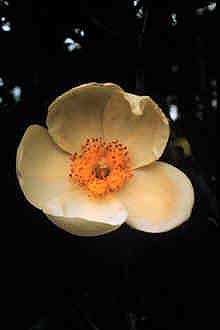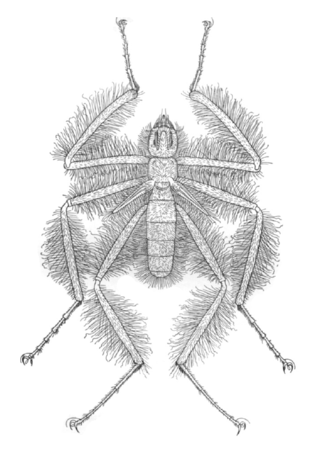
Theaceae, the tea family, is a family of flowering plants comprising shrubs and trees, including the economically important tea plant, and the ornamental camellias. It can be described as having from seven to 40 genera, depending on the source and the method of circumscription used. The family Ternstroemiaceae has been included within Theaceae; however, the APG III system of 2009 places it instead in Pentaphylacaceae. Most but not all species are native to China and East Asia.
Jack Hill State Park, formerly named Gordonia-Alatamaha State Park, is a 662-acre (268 ha) Georgia state park located in Reidsville, a city on Georgia's coastal plain region. The park is known for having a dramatic history, having been previously under water for nearly 20 million years. Until about 1 million years ago, the area was very similar to the dense jungles and plains of Africa. The park was named for the nearby Altamaha River and the park's nearly extinct Gordonia Tree. The park contains a 12-acre (4.9 ha) lake stocked with fish, as well as a 9-hole golf course, named Brazell's Creek, which has recently been upgraded to 18 holes.

Gordonia is a fairly typical, although sizeable Main belt asteroid.

Gordonia is a genus of flowering plants in the family Theaceae, related to Franklinia, Camellia and Stewartia. Of the roughly 40 species, all but two are native to southeast Asia in southern China, Taiwan and Indochina. The remaining species, G. lasianthus (Loblolly-bay), is native to southeast North America, from Virginia south to Florida and west to Louisiana; G. fruticosa is native to the tropical rainforests of Central and South America, from Costa Rica to Brazil.

Gordonia was a Zionist youth movement. The movement's doctrines were based on the beliefs of Aaron David Gordon, i.e. the redemption of Eretz Yisrael and the Jewish People through manual labor and the revival of the Hebrew language. In Gordonia the cadets learned Hebrew and the graduates organized themselves into training groups pending aliyah to the Holy Land.

Nepenthes hirsuta, the hairy pitcher-plant, is a tropical pitcher plant endemic to Borneo. It is characterised by an indumentum of thick brown hairs, which is even present on the inflorescence. Pitchers are mostly green throughout with some having red blotches on the inside surfaces.

The family Mormotomyiidae contains only one known species, Mormotomyia hirsuta, commonly known as the frightful hairy fly or terrible hairy fly, which is found in Kenya. The fly was first described by English entomologist Ernest Edward Austen, and specimens have been collected from one location on a mountain in the Ukasi Hill, in a cleft where a bat roost is located; this may possibly be the most restricted geographic distribution for any fly family. The larvae have been collected from bat guano. Adult flies are believed to feed on bodily secretions of bats. The fly measures about 1 cm long, with hairy legs, and, due to its nonfunctional wings and tiny eyes, looks more like a spider than a fly. Specimens have been collected only three times, in 1933, 1948, and 2010. Tested members of the population showed higher levels of genetic variation than would be expected for such a restricted range, suggesting that additional undiscovered populations exist with gene flow occurring between them and the known population in Ukasi Hill.

Nepenthes hispida is a tropical pitcher plant species native to Borneo. It grows at elevations of 100 to 800 m in kerangas forest. It is known with certainty only from Lambir Hills National Park and surrounding areas.

The hairy big-eared bat is a bat species from South and Central America, as well as Trinidad and Tobago in the Caribbean.

Arabis hirsuta, known as hairy rock-cress, is a flowering plant of the genus Arabis in the family Brassicaceae. In previous North American works, this species has been broadly defined to include plants native to Europe, Asia, and the northern half of North America, but is now more often restricted to a narrower subgroup restricted to Europe.

The Karoo long-billed lark or Karoo longbill is a species of lark in the family Alaudidae. It is found in southern Africa in its natural habitat of subtropical or tropical dry shrubland.

USS Gordonia (AF-43) was an Adria-class stores ship in service with the United States Navy from 1945 to 1946. She was scrapped in 1974.

The flavanonols are a class of flavonoids that use the 3-hydroxy-2,3-dihydro-2-phenylchromen-4-one backbone.

Gordonia is an extinct genus of dicynodont therapsid from the Late Permian of Scotland. Fossils have been found from the Elgin sandstone of Cutties Hillock Sandstone in Elgin, Moray. These are among the many amniote fossils referred to as the Elgin Reptiles. Gordonia was named in 1893 with four species: G. traquairi, G. duffiana, G. huxleyana, and G. juddiana. Currently, the only recognized species is the type G. traquairi. All other species are considered synonyms of the type.
Gordonia is a 2010 documentary film directed and produced by New Zealand filmmaker Tom Reilly.

α-Spinasterol is a stigmastane-type phytosterol found in a variety of plant sources such as spinach, from which it gets its name.
Gordonia is a genus of gram-positive, aerobic, catalase-positive bacterium in the Actinomycetota, closely related to the Rhodococcus, Mycobacterium, Skermania, and Nocardia genera. Gordonia bacteria are aerobic, motile, and non-sporulating. Gordonia is from the same lineage that includes Mycobacterium tuberculosis. The genus was discovered by Tsukamura in 1971 and named after American bacteriologist Ruth Gordon.. Many species are often found in the soil, while other species have been isolated from aquatic environments. Gordonia species are rarely known to cause infections in humans.
Gordonia alkanivorans is a bacterium from the genus of Gordonia which has been isolated from soil which was contaminated with tar and phenol in Rositz in Germany. Gordonia alkanivorans has the ability to metabolize hexadecane. The strain RIPI90A of Gordonia alkanivorans can desulfurize dibenzothiophene.
Gordonia rhizosphera is a bacterium from the genus Gordonia which has been isolated from rhizosphere soil from a mangrove plant in Japan.













